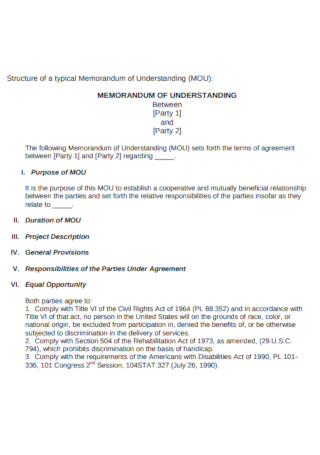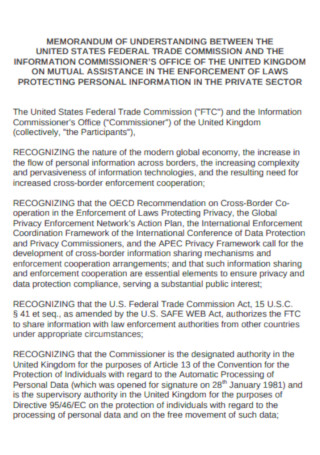Memorandum of Understanding
-

Memorandum of Understanding
download now -

Simple Memorandum of Understanding
download now -

Memorandum of Understanding Template
download now -

MOU on Bilateral Cooperation
download now -

Emergency Management Memorandum of Understanding
download now -

Cooperating Organization Memorandum of Understanding
download now -

Technology Memorandum Of Understanding
download now -

Sample Health Organization for Memorandum of Understanding
download now -

Basic Memorandum of Understanding Template
download now -

Enterprise Memorandum of Understanding Template
download now -

Simple Memorandum of Understanding Template
download now -

Memorandum of Understanding for Cooperation Template
download now -

Standard Memorandum of Understanding Template
download now -

Sample Tripartite Memorandum of Understanding Template
download now -

Sample Found Memorandum of Understanding Template
download now -

Partnership Memorandum Agreement of Understanding Template
download now -

Renewal of Memorandum of Understanding
download now -

Memorandum of Understanding and Letter of Intent Template
download now -

Club Memorandum of Understanding Resources Template
download now -

Sample Structure of a Typical Memorandum of Understanding Template
download now -

Memorandum of Understanding on Co-Operation Template
download now -

Memorandum of Understanding Deferment of Assessment Template
download now -

Memorandum of Understanding for the Promotion Template
download now -

Memorandum of Understanding for Emergency Purchase Template
download now -

Standard Institute of Technology Memorandum of Understanding Template
download now -

Federal Trade Commission Memorandum of Understanding
download now -

Memorandum of Understanding for Shared Services Template
download now -

Memorandum of Understanding for Computer Society
download now
FREE Memorandum of Understanding s to Download
Memorandum of Understanding
What Is a Memorandum of Understanding?
Components of a Memorandum of Understanding
Why Use a Memorandum of Agreement?
How to Make a Memorandum of Understanding
FAQs
How do you differentiate a letter of intent from a memorandum of understanding (MOU)?
Do you need to consult a lawyer before signing an MOU?
Do you need to consult a lawyer before signing an MOU?
What Is a Memorandum of Understanding?
While not legally binding, a memorandum of understanding (MOU) signals that both parties are geared towards setting up a contract. It is a concise written agreement among companies and organizations. It presents an outline of scopes, limitations, and restrictions that they’ve agreed upon. It can also be seen as a preliminary document that can be later on added or expanded on a contract. This ensures that both parties know their responsibilities towards each other, the benefits they’re entitled to get, and the risks they’ll share.
Thriving in business is hard enough on your own, and bringing in someone to do it with you can be daunting. While it’s certainly helpful and beneficial, the obligation it entails can be a burden, but why are collaborations important?
Collaborations are a trend among business giants in the industry. You know why? Because brand partnerships work. A prime example of this is Kanye West and Adidas’s collaboration on Yeezy that resulted in a billion success. With Adidas’s popular standing in the market and West’s promotional genius, the figures were no surprise. When two notable brands merge to fulfill an initiative, they are not only bringing their resources and expertise to the table. They bring both their audiences, doubling the population size of their target market, therefore increasing the chances of a boost in profit.
Before stepping up to agree with a contract, an MOU can be a good stepping stone to take up. It allows you to sit for an initial discussion, settle your differences, and come up with a common goal without the weight of a legal obligation hanging around your neck. This is a huge help, especially for those who are new in business who haven’t explored the complexities of a partnership.

Components of a Memorandum of Understanding
An MOU varies in different settings and arrangements. In many ways, it’s similar to a letter of intent, which may also a non-binding agreement that may also signal that a contract signing is already around the corner. But an MOU contains elements that are vital to its content. Below are some general information necessary to an MOU:
1. Time period – your MOU should state the start and end dates of a deed or project.
2. Risks – this answers what responsibilities each party will shoulder in the event where a hazard or a violation occurs. This should name specific roles or individuals.
3. Financial arrangements – this states how the payment works and who is responsible for them.
4. Responsibilities – this part is the main highlight of any MOU. This contains individual and shared responsibilities of every party involved in the agreement in detail.
5. Involved parties – it’s vital to name not only the organization labels but also the individuals who have direct roles to fulfill the MOU.
6. Disclaimer – If there are any reservations or reminders that the agreement might like to add, placing a separate paragraph for the disclaimers is necessary.
7. Signatures – an MOU might night legally binding, but a signature is needed to signify that everyone has read and understood the contents.
Why Use a Memorandum of Agreement?
In an incident dubbed by The Guardian as the “memo of misunderstanding,” a televised international trade talk involving China and United State’s representatives and attended by President Donald Trump himself was interrupted by a disagreement. Trump had a slight argument with his trade negotiator, Robert Lighthizer, over the definition of MOU. Trump said that MOUs mean nothing which Lighthizer contested by saying that an MOU is also a contract. Trump contradicted Lighthizer, and the pair went back and forth until they decided to change its name to trade agreement.
The MOU’s unbounded nature might make it seem like a “negotiated promise” rather than an airtight understanding between two parties. The president’s disapproval of it can also be a factor. However, there are still numerous reasons why an MOU is useful. They are as follows:
How to Make a Memorandum of Understanding
Getting into a new alliance can intimidating. But sitting down with your partners to discuss its contents may require tedious decision making. However, getting all of them on paper is no easy task. A single error on your MOU can mean serious complications in the future. Follow the guidelines on how you efficiently put your MOU together:
Step 1: Prioritize Your Main Points
Before you can come up with a full transcript of your memorandum, it’s best to review every main point that both parties have agreed to heed. To effectively relay accurate details, you can start by listing down the points as phrases. From there, you can start filling in the necessary specifications by using bullets or numbered paragraphs, whichever you prefer. It is important to note that the details are laid out clearly and thoroughly to avoid misunderstandings that automatically defeat the purpose of the document. No matter how detail-oriented you can get, strive to present your points as concise and simple as possible. Remember: lengthy doesn’t equate being meticulous.
Step 2: Know the Necessary Details
Aside from the main body of the MOU, you should know what other details it needs. This way, you’ll be able to easily make your draft without missing anything crucial to the agreement. With that in mind, you must first and foremost include the parties involved. Your MOU should not only clearly state the name of an organization but the key persons who are directly responsible for the items provided in the agreement. There should be a background context of the agreement’s purpose as well as a perceived outcome when the MOU is implemented. The responsibilities to be performed should be labeled and designated correctly. These details are crucial in ensuring that no complications will arise in the future.
Step 3: Beware of Accidental Bindings
While it’s clear that an MOU doesn’t have legal enforcement, some points can be binding unintentionally. This depends on how you’ve written your terms. Without meaning to, your agreement content may have statements that have legal weight. To help you avoid that, below are some points that might help identify which part may make your MOU legally binding:
1. When there’s a non-disclosure clause or confidentiality clause involved, it is often stated in a way that makes it legally binding.
2. When it includes significant details about payment, organizational roles, delivery of services, or corresponding consequences when there’s a violation.
3. When there’s a parallel agreement, and a clause present in the MOU also appears in another agreement that’s legally binding,
4. When there’s no statement specifying that any legally binding is merely unintentional.
Step 4: Include Boilerplate Clauses
Boilerplate clauses or miscellaneous provisions are those that are located at the very end of every contract or agreement. They contain statements such as instances where the document may become invalid, or on what jurisdiction does it belong to. Because they’re at the end and are usually phrased in standard language, it’s often overlooked. However, a boilerplate clause is important and shouldn’t be taken for granted. In the case of MOUs, it may contain amendments, counterparts, and notices that are necessary for dealing with future conflicts or changes in the document.
FAQs
How do you differentiate a letter of intent from a memorandum of understanding (MOU)?
US law recognizes a letter of intent and an MOU as similar. A letter of intent contains preliminary terms prior to the making of an agreement as much as an MOU can have provisions that might appear in the formal contract. However, a letter of intent can never be binding compared to an MOU that can have terms that might have legal weight unless a disclaimer is issued.
Do you need to consult a lawyer before signing an MOU?
Because there’s a risk that your MOU can be binding, it’s best to consult a lawyer when drafting the document to ensure that there are no unintentional liabilities that might prove to be a problem in the future.
Do you need to consult a lawyer before signing an MOU?
Because there’s a risk that your MOU can be binding, it’s best to consult a lawyer when drafting the document to ensure that there are no unintentional liabilities that might prove to be a problem in the future.
Amelia Earhart, the first woman to fly solo across the Atlantic Ocean, might have navigated the air alone, but she never attributed the success solely on herself. In her book, “Last Flight,” she said that her husband’s encouragement was one of the reasons why she achieved that feat. Partnerships are investments where you bargain trust for trust. In an industry where everyone can be a competitor, a partner comes hardly by.
